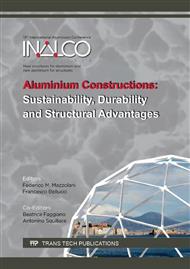p.169
p.175
p.181
p.186
p.192
p.198
p.204
p.210
p.216
The Use of Cold Spray to Repair Corroded AA6005A-T6 Used for Bolt-Channel Joints
Abstract:
The cold spray technology is an innovative technique used to coat metallic and non-metallic substrates for protection from corrosion and/or to improve surface functionalities. It is well known that surface degradation (i.e. corrosion) is not merely an aesthetic issue; its consequences may affect the structural behaviour and the usability of structures or parts of them. This paper addresses the use of cold spray technology as a potential innovative tool for the repair of an extruded 6005A-T6 aluminium alloy item. The specimens investigated have a complex geometry and are used for a new kind of bolt-channel joints to secure the passenger seats to the frame of buses. In order to simulate environmental degradation, samples were exposed to aerated synthetic seawater for 15, 60 and 240 days and, subsequently, cold spray coated using a pure aluminium powder. Results acquired show that layers obtained using Cold Spray process are effective against corrosion, restore volume and geometry shape of corroded metals components without showing visible traces of the repair.
Info:
Periodical:
Pages:
192-197
Citation:
Online since:
September 2016
Keywords:
Price:
Сopyright:
© 2016 Trans Tech Publications Ltd. All Rights Reserved
Share:
Citation:


